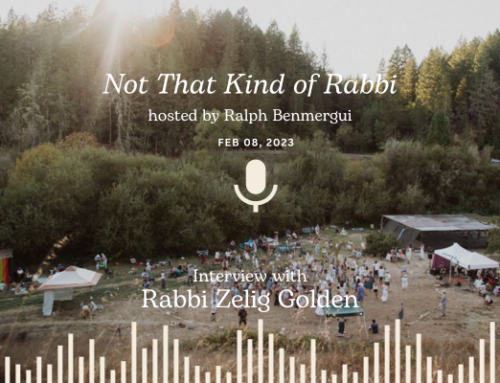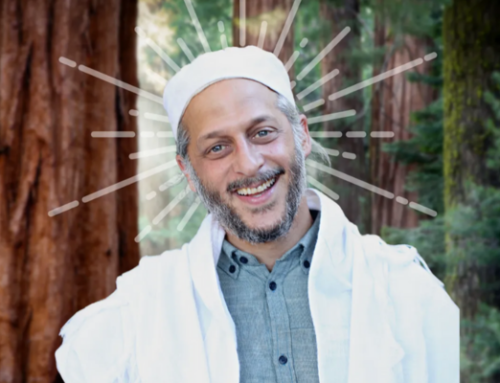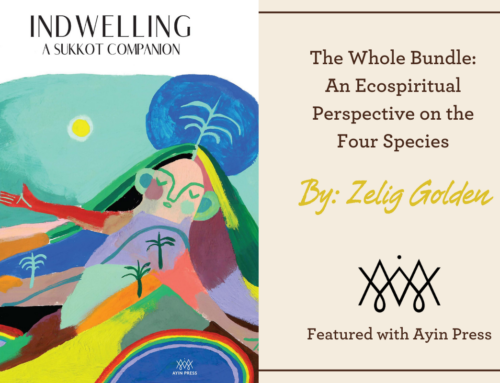Tishrei 1 | Erev Rosh Hashanah 5783
Text Version Below:
I am acutely aware that our beautiful world faces awesome challenges. I constantly follow Russia’s war in Ukraine, praying that freedom will prevail over facism, while Florida’s hurricane, Pakistan’s flooding, and California wildfires remind me of the real threat we face from climate change.
This Rosh Hashanah, I feel called to share words of Torah and about the work that Wilderness Torah envisions for the next 7 years to build resilient village during destabilizing times.
Charging the Divine Field
We learn from Rabbi Isaac Luria, the great 16th century mystic, that the work of the High Holy Days is “Binyan HaMalchut,” literally “Building the Kingdom or Queendom” – Building this earthly realm by offering Spiritual nourishment to the world.
Rabbi Zalman Schacter Shalomi, z”l, my dear elder and teacher, loved the Ari’s concept of Binyan HaMalchut – calling it “Recharging the Divine Field.” Reb Zalman teaches:
Depletion of the God-field is a natural consequence of the huge draw thatsustaining our world demands … and the Field can fray when we get too far off track … violence, cruelty, injustice, oppression – these destructive powerssurge through the God-field wreaking damage and shorting-out connections.
He teaches, when we lean in with our intentions, prayers, and good conduct in this world – we nourish the world. These holidays can have a real and potent effect on the world. As the late Rabbi Lew teaches: “This is real.” On Rosh HaShanah, we begin a cycle of renewal and repair with an opportunity to bring fresh energy that heals and repairs the tattered weave and opens blocked channels; and that heals us so that we can correct our failures to walk upright in this world.
Rosh Hashanah’s Instructions
Embedded in its many names and ritual offerings lie instructions for how to set our intentions, orient our prayers, and conduct ourselves on Rosh Hashanah.
Known as Yom HaDin – day of Judgment – Rosh Hashanah teaches that the Book of Life opens, and then seals on Yom Kippur. From Jewish mysticism, Din correlates to Gevurah – power and strength. Rather than some external judgment process, Rosh Hashanah calls us to consider:
- Where am I misusing my power?
- Where is the true seat of my power?
- What blocks me from a balanced way with power?
Known as Yom Teruah – day of sounding – on Rosh Hashanah we are instructed to hear the shofar, the primordial sound that helps us release our energetic blockages – such as old culture stories and limiting beliefs – so that we can really do Teshuva – spiritual realignment. Rosh Hashanah calls us to consider:
- What old stories no longer serve?
- What patterns block me from full alignment?
Known as Yom Hazikaron – day of remembering – Rosh Hashanah reminds us that we humans forget. The High Holidays call us back to re-member, return to wholeness and our original instructions. Rosh Hashanah calls us:
- To consider what we have forgotten, and
- Deeply listen, so we can remember the most important things in life
Finally known as HaYom Harat Olam – the day of “eternal conception” – Rosh reminds us that anything is possible. Today is an access point in time into infinite possibilities. At the very least, today is the time for potent new beginnings – Rosh Hashanah calls us to consider:
- What are we really here for?
- How do we set a course to manifest that?
New Seven-Year Cycle
This Rosh Hashanah is particularly potent because we gather to renew the Field not just for the new year 5783, but for the Next seven years. In the Shmita year, we are instructed to rest the land, revert debt, and free those in servitude – why do this? Yes, for the sake of resting and renewing in the shmita, and to change us for subsequent years. Shmita is the ultimate regenerative design principle. For shmita to really work, we must be thoughtful about how we tend the next 6 years.
Rabbi Abraham Isaac Kook, the great early 20th Century mystic, explained it this way:
This once-every-seven-year illumination carries an afterglow of divine idealsthat will gradually shape our ethical charactersso that the outlook that flowsfrom them will become a deeper and more formative part of us.
The divine ideals of shmita provide an ancient pathway for regenerative culture today. When we honor shmita, it changes us for the years that follow.
- How did you practice shmita this past year?
- What did you learn and how has Shmita changed you?
Wilderness Torah’s Work to Charge the Field
We at Wilderness Torah took the shmita year to heart, slowed down, released community programs, and deeply reflected on our evolution. With many of you, we dug into how Wilderness Torah can Recharge our Village for the next seven years.
This shmita year we engaged in an 8 month Strategic planning process. Thank you to all who engaged in this process – we hope it inspires you and we look forward to hearing from you.
In the next 6 years, we will bring more village-building programs for all ages to you across the Bay Area – East Bay, San Francisco, Marin and Sonoma. Nevatim (“sprouts”) is our new family and tot programs; B’hootz, our Forest Sunday School has launched groups across the Bay. Neshama “Soul” Quest – weeklong backpacking trips – are opening up potent new horizons for teens. We will expand Shabbat and learning offerings and bring back our multi day village-building festivals – Sukkot on the Farm and Passover in the Desert.
This shmita year we also journeyed through a year-long community Design Charrette process to dream and design the Center for Earth Based Judaism – Thank you for all who participated in the community charrettes and in particular we thank the amazing Erik Ohlsen, master permaculture designer, and Malka Hoffman who guided us through the design process.
We will partner with URJ Camp Newman, to create the Center for Earth-Based Judaism. Ala Yom HaZikaron, we remember our original instructions as earthlings who thrive when we are deeply rooted to nature and the village. The Center will become a place to call home, learn permaculture skills (imagine tending an orchard where you can harvest your 4 lulav species each year) and ancestral skills (imagine making your holiday candles from beehives and weaving a tallit from a flock of sheep). We will tend this land to learn climate change resilience, tend fire and water as ecological elements to be balanced in a fire prone landscape, and spiritual elements to be honored in our ancient rituals.
This Shmita year we also delved into Culture Change Work – exploring power dynamics, inherited patterns related to colonization, patriarchy, and white supremacy – we examined how we can become a healthier more diverse, equitable, inclusive, and just community – so we can embody the change we yearn to see in the world.
Personally I am increasingly aware that I am a work in progress. I’m deeply grappling with how these legacies live within me, growing in awareness when to step up and when to step aside. This is the work of a lifetime, and I am committed to this work. Wilderness Torah is committed to this work.
In this next seven years, we aim to Take Wilderness Torah’s Village Building to the next level to charge the field of community and our world. I hope you find it inspiring for how you are involved in Wilderness Torah, and for how you personally rise up to meet the many challenges we face today.
We Rise to support each other to heal, find our gifts, and serve in community. More than ever, we understand the importance of interconnection – COVID taught us about isolation – we know none of us can live a resilient life alone.
We Rise to support a culture of initiation that takes all life stages into account. Watching the deep rifts in society, we can no longer support prolonged adolescence that breeds selfishness, unfettered consumption, and abuses of our world.
Rebbe Nachman of Breslov, the great grandson of the Ba’al Shem Tov, teaches “each individual blade of grass, leaf, shrub and tree sings its unique praise to God … which brings new vitality to the entire creation.” Nachman says the same of each earthling – we each come to earth with a Tachlis– a unique purpose – that is encoded in our unique soul. We are all needed!
We Rise to create a village where we can discover and share our gifts, cultivate collaborative leadership, mutuality, and radical inclusivity. Ala Yom HaDin, we lean in to unravel inherited stories and power structures and embrace the truth that diversity begets resilience. Just as a forest needs species diversity for health, our community needs our full diversity to be resilient. We are learning how we fail to hear, see, and include many that have been marginalized for too long, and we set a new course where leadership reflects our full diversity.
We Rise by creating clear pathways to learn from each other and safely give and receive feedback when there is harm, mistakes are made, or when something great happens. For example, on the front page of Wilderness Torah’s website you’ll find a new portal to share feedback anonymously or with a request for follow up.
We Rise by beginning a new path of indigenous solidarity. Ala Yom Teruah, we awaken to the truth of colonization and acknowledge how we inherently benefit from this gruesome past – we will build bridges to indigenous communities where we live and where we will build the Center for Earth-Based Judaism – with Pomo, Miwok, Onatsatis and other native peoples living in these lands, we will lean in to repair, reparations, and partnership in common cause of culture repair and earth care.
I will invite you to reflect on how you will rise up in the next cycle…
- How will you set the next 6 years in motion?
- How will you heal, find your gifts, and serve community?
- How will you dismantle the systems of oppression that live in you?
- How will you step into allyship with those marginalized for too long?
- How will you mentor the young ones and honor the elders?
- How will you build village, wherever you are, so that you and all that you are connected to will thrive?
I now Invite you to Rise in body or spirit, as we sing together Batya Levine’s anthem, We Rise.




